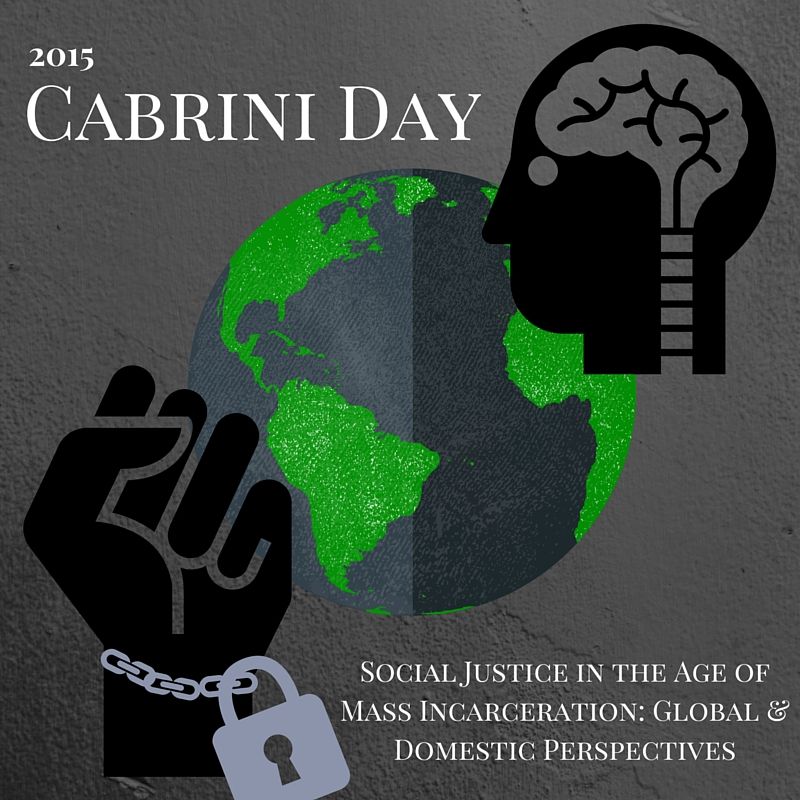
“More than two million people in America are put behind bars, which is the largest in the world,” Marc Mauer, author of Race to Incarcerate and the executive director of the sentencing project, said in his keynote address on Cabrini Day.
According to Amnesty International the United States only accounts for 5% of the worlds population, and 22% of the worlds prison population.
The issue of mass incarceration in the United States was the main topic of focus for Cabrini Day 2015. Cabrini Day is a chance for the campus community to take a step back and learn and reflect about social justice issues bigger than themselves.
Assistant professor of sociology, Dr. Andrew Owen, volunteered to chair Cabrini Day. Assistant professor of criminology, Dr. Katie Farina, and assistant professor of criminology, Dr. Vivian Smith, co-chaired the day with him.
“We know that mass incarceration is a huge problem in this country so with that experience we just felt that this was an issue that we wanted to share with the community,” Dr. Owen said.
He and Dr. Smith taught a course at the Montgomery County Correctional Facility in the spring as part of the inside-out program part of the ECG 300 class offered here at Cabrini which allows students to learn side-by-side the inmates.
“I think we were both just impacted emotionally by working with these individuals who are incarcerated,” Owen said.
Marc Mauer believes that the prison population is seven times larger than that of the 1970s comes from changes in sentencing policy rather than crime rate. More people are in prison for longer terms.
Half of a million incarcerated people are in jail because of drug offenses. The Drug Enforcement Administration (DEA) upholds a minimum sentence for drug trafficking in the U.S for a first offense to be no less than five years and no more than 20 years and that is just if no one received any bodily injuries during the act.
But what about the families of the incarcerated? What happens to them?
A 2014 study done by Brown University states that children who grow up with incarcerated family members are more likely to be in poor health as adults.
Carla Clanagan, Executive Director, In His Eyes Outreach was present on the panel entitled, “Collateral Damage: Unforeseen Consequences of Imprisonment in America.” She reported that the trauma a child goes through when one parent is incarcerated is equivalent to that of a war veteran or someone in a hostage situation.
Clanagan also said that she is working in certain prisons to make more “family friendly” rooms where children can go to be with their incarcerated parent. “These rooms have murals on the walls and toys for the kids to play with. It makes their care givers more comfortable bringing them to the prisons to visit,” Clanagan said.
About 68 percent of incarcerated people end up back in jail. Clanagan said that the reason they end up back in jail has a lot to do with what their lives are like once they get out. After a person has been incarcerated he/she and their family can no longer live in public housing or receive welfare and food stamps.
While focusing on the issue of mass incarceration in the United States, students had the opportunity to pick a social justice issue to bring to the attention of the community. Those who went to the Dixon center listened to short presentations made by students including mass incarceration, world hunger and climate change. Members of the community voted on their favorite group and individual presentations. Second place for both categories received $50 checks and first place winners received $100 checks to be donated to the charity of the winner’s choice.
For the third year in a row, Dr. Jerry Zurek’s ECG 100 class entitled, “Our Interconnected World,” took home first prize for group presentation with a simulation about climate change and the part each individual plays.
“I hope people got a better understanding of how close to home climate change is,” freshman communications major and member of the winning team, Anthony Spitery, said. “There are a lot of things people need to be aware of and I think the simulation brought that to life.”
Emily Rowan/Photo Editor


